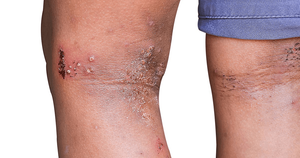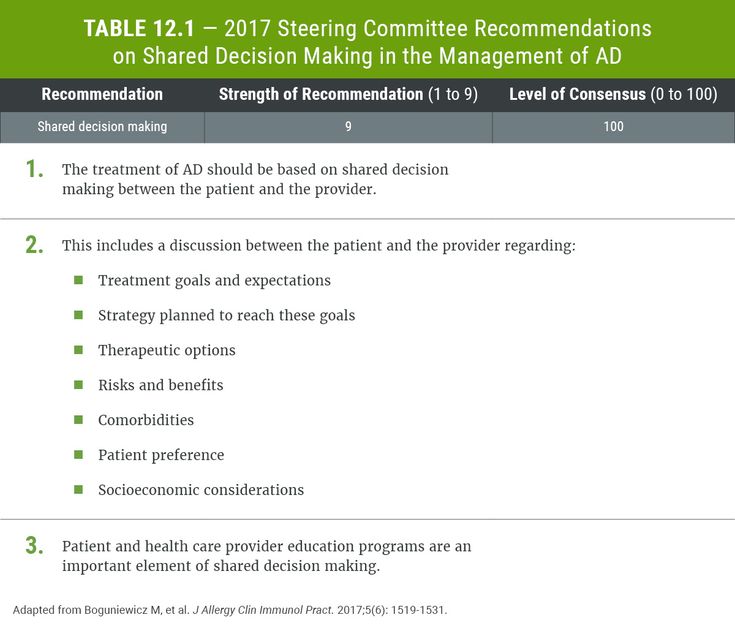Coordinated Management
Introduction
Atopic Dermatitis (AD) is not just “skin-deep.” AD affects all aspects of patients’ lives, including their mental health, sleep and physical function and is associated with a myriad of comorbid health conditions. AD treatment regimens emphasizing good skin care, appropriate treatment with topical and systemic agents and adjunctive therapies (e.g., wet wrap therapy, antibiotic use in patients with evidence of skin infection) can help achieve disease control and may prevent the development of other atopic comorbidities. However, treatment plans that should be optimal for efficacy may still be limited by a number of factors, including patient adherence, concerns over adverse effects, limited cooperation in young children, psychological barriers, limited healthcare access, high out of pocket costs, the inappropriate application of topical agents, the time-intensive and labor-intensive nature of complex skin care routines and others. These barriers limit the…
To continue reading
Log in or register to continue reading. It's free!
OR
By signing up to create an account, I accept Healio's Terms of Use and Privacy Policy.
Introduction
Atopic Dermatitis (AD) is not just “skin-deep.” AD affects all aspects of patients’ lives, including their mental health, sleep and physical function and is associated with a myriad of comorbid health conditions. AD treatment regimens emphasizing good skin care, appropriate treatment with topical and systemic agents and adjunctive therapies (e.g., wet wrap therapy, antibiotic use in patients with evidence of skin infection) can help achieve disease control and may prevent the development of other atopic comorbidities. However, treatment plans that should be optimal for efficacy may still be limited by a number of factors, including patient adherence, concerns over adverse effects, limited cooperation in young children, psychological barriers, limited healthcare access, high out of pocket costs, the inappropriate application of topical agents, the time-intensive and labor-intensive nature of complex skin care routines and others. These barriers limit the effectiveness of even the most well-planned treatment regimen and negatively impact patient quality of life. For example, the psychological stress associated with the condition and frustration from inadequate control can trigger scratching, which exacerbates symptoms and establishes a vicious cycle that proves challenging to manage.
In addition, pruritus can be associated with significant sleep disruption, symptoms of depression, anxiety, inattentiveness and associated daytime dysfunction when AD is uncontrolled. Patients with AD are also at higher risk of comorbid atopic, infectious, autoimmune, respiratory, neuropsychiatric, musculoskeletal and potentially even cardiovascular and malignant disorders. Due to the complex and possibly systemic nature of AD, multidisciplinary approaches to care have been established to more effectively address the biological, psychological, behavioral and dietary features of the disease. This chapter will review the key roles that multidisciplinary team members play in the management of AD.
Shared Decision Making
In 2017, a multidisciplinary steering committee of AD experts made recommendations concerning new developments in the management of AD (Table 12-1). The steering committee recommended that treatment decisions be based on shared decision making between patient and provider, with patient preferences and goals being taken into consideration. Prior to initiating therapy, patients should be sufficiently informed regarding treatment goals, limitations, conditions that may affect treatment choices and the risks and benefits associated with a given therapy. By being informed on all therapeutic options available, and the reasons for choosing one treatment over another, patients become active participants in the management of their disease.
Multidisciplinary Team Members
AD Specialist
Since many AD patients have tried a myriad of medications and skin care techniques, it is important for the AD specialist to perform a detailed review of the patient’s history, including prior regimens and allergy evaluations. Following a review of the patient’s history, a stepwise treatment plan should be devised with the patient, individualized to the severity of their disease and considering all relevant factors (e.g., comorbid conditions, concomitant medications, preferences). Evaluation of AD triggers should be performed, although it should be made clear that avoidance strategies will help mitigate active disease and minimize flares, but will not cure the disease.
Patients often look for a magic bullet or a single trigger for their disease, without realizing the complex, multifactorial nature of AD and the many triggers thereof. Food allergy testing should not be done unless the patient has a reliable history of an immediate allergic reaction after ingesting a specific food or persistent disease despite optimized management and topical therapy, since unnecessary food avoidance can be harmful to patients and reduce their quality of life.
Patient sleep and mood assessment should also be performed, since nighttime itching can significantly impair sleep and have negative consequences on children’s cognitive functioning, mood, attention and behavior.
A comprehensive treatment plan should consist of the following elements:
- Daily skin and bathing routine
- Environmental controls and triggers to avoid
- Instructions for management of skin flares
- Instructions for maintenance therapy for prevention of flares
- Itch management guidelines
- Behavioral strategies to break the itch-scratch cycle
- Strategies to promote sleep
- Strategies to promote cooperation of children, if relevant
- Allergy and nutritional recommendations, if relevant.
A written treatment plan should be developed for patients to review after the encounter. The treatment plan should be carefully reviewed during the encounter by the clinician or qualified nurse as an integral initial step in patient education. Attempts should be made to clarify any misconceptions or discuss any patient concerns. For example, concerns about adverse effects associated with topical corticosteroid or calcineurin treatment may cause nonadherence or under-dosing. Discussing such concerns has been shown to improve adherence. Patients may also develop coping strategies of their own, some of which may worsen their condition (e.g., excessively hot baths or showers for short-term reduction of itch). Discussing the treatment plan, including ideal bathing and skin care practices, can help bring these improper practices to light. Upon completion of the treatment plan, the patient should understand how to implement the plan to help extend periods of remission.
Patient/caregiver education is a continuous process and can be strengthened by discussing the treatment plan at each follow-up visit, especially when it is modified, to help ensure it is properly understood. It is important to note that adequate patient education can take a considerable amount of time, and may be challenging in different practice settings. However, without proper and thorough education, most patients will not achieve adequate disease control. Thus, clinicians should find practical solutions to aid in educating patients, including employing the assistance of well-trained physician extenders, in-office videos and ample written material for patients to review.
The AD specialist also plays an essential role in recognizing barriers to disease control, such as inappropriate application technique, emotional stress, high out-of-pocket costs, child resistance, and dietary restrictions. Resolving these barriers is a goal of the multidisciplinary team, with each member contributing their own specialized knowledge and skill set.
Mental Health Specialist
Mental health specialists, including psychologists and psychiatrists, can help patients develop effective stress management strategies and identify any behavioral or emotional triggers of the itch-scratch cycle. Psychological interventions have been shown to be effective at reducing itch intensity, scratching and disease severity. In adults, effective interventions include relaxation training, stress management, habit reversal and others. In children, hands-on activities to redirect their attention, such as coloring or squeezing a stress ball, may be effective. Psychological interventions may also help improve sleep hygiene. For example, relaxation strategies can help children fall asleep without the presence of an adult. Psychologists may also provide effective strategies to improve cooperation in younger children, such as games that distract from the stinging caused by topical treatments. Lastly, patients with chronic AD have higher rates of mental health disorders, such as major depressive disorder and generalized anxiety disorder, even at times when the skin is clear. Mental health specialists can provide counseling and/or pharmacological treatment for such patients.
Registered Nurse/Nurse Practitioner
Nurses play an essential role in educating patients and caregivers about AD and its associated treatments. In pediatric patients, nurse-led educational interventions have been shown to improve disease severity, reduce patient confusion surrounding skin care, improve use of prescribed medications and increase parental confidence in following treatment plans.
Dietician
If food allergies are present in conjunction with AD, as is the case in up to 35% of infants and children with moderate-to-severe AD in some cohorts, then a registered dietician can help in the management of AD. Long-term food avoidance strategies are associated with a variety of growth issues, including lower weight, shorter stature and nutritional deficiencies. Anecdotally, I have several patients who developed pellagra, scurvy and early stages of kwashiorkor secondary to nutritional deficiencies related to fad diets and misguided food allergen avoidance. Dietary counseling has been shown to improve these growth measures among children suffering from food allergies.
Sleep Medicine Specialist
Sleep disturbance is common in children and adults with active AD, owing to AD-associated pain, itch, dysregulated production of cytokines and melatonin and other causes. In some cases, sleep disturbances may persist despite AD remission, especially if the patient develops maladaptive sleep patterns or poor sleep hygiene during periods of active disease. In these scenarios, the patient should be referred to a sleep medicine specialist in order to properly diagnose and manage the sleep disturbances.
Patient Education
The pathogenesis of AD is complex, and treatment often involves multiple, rotating therapies. As such, effective management requires teaching and support to achieve and maintain disease control. Patient/family education regarding the chronic relapsing nature of AD and the proper implementation of the treatment plan, including appropriate dosing and application, can help establish good self-care practices and promote consistent use of all prescribed elements. Increased patient/caregiver knowledge has been shown to improve adherence and AD severity and QOL measures in both children with AD and adults with moderate-to-severe AD.
Due to limited office time, patient/caregiver education cannot be solely provided by the AD specialist. As such, patients should be made aware of access to structured patient education programs. Such programs vary in terms of size, scope, intensity, setting, frequency and personnel leading them. The largest randomized study of a structured patient education program was performed in Germany and enrolled 823 children and adolescents with moderate-to-severe AD and their families. The program consisted of 6 weeks of once-weekly 2-hour educational sessions with psychological, dermatologic and nutritional components. Compared to the control group, education training resulted in decreased disease severity, as judged by the Scoring AD (SCORAD) index, relative to the control group (P=0.0002 in children 3 months to 7 years of age, P=0.003 in children 8 to 12 years of age, and P <0.0001 in adolescents 13 to 18 years of age). Significant improvements were also observed in the objective component of the SCORAD index, subjective severity (assessed via standardized questionnaire), itching behavior and quality of life measures, including emotional coping and acceptance of the disease.
Standardized video instruction offers an alternative to workshops and nurse-led educational sessions as a form of parental education. Such an approach is less time-consuming and was shown in one trial to be more effective than direct parental teaching in improving AD symptoms. In a second trial, video instruction led to greater improvements in severity score and AD knowledge compared to pamphlet-based learning.
Many patients and caregivers do not properly apply topical medications. As such, a critical component of patient education is ensuring that patients are clear on the quantity of topical medications and moisturizers to use during each application. An easy-to-follow rule for topical corticosteroids is that of the fingertip unit, defined as the amount of topical steroid expelled from a tube with a 5-mm diameter nozzle and spanning from the tip of the palmar surface of an adult index finger to the distal skin crease. This amount (~0.5 g) should be applied in a thin and even layer across an area equivalent to approximately two adult hands with fingers together. Of note, this quantity is far greater than some recommendations given by clinicians to apply a very thin layer and/or rub in the medication all the way. Such recommendations typically result in inadequate quantities of medication used and poor treatment efficacy.
Another component of patient education includes promoting good skin care practices. This involves regular skin hydration with warm or cool showers or baths, followed by the immediate application of moisturizer to the damp skin. Proper hydration strengthens the skin barrier and increases the patient’s threshold for skin irritation, thus reducing the risk of reacting adversely to certain environmental triggers.
Patients should also be educated about commonplace irritants, including harsh detergents, tight-fitting clothes, aeroallergens and extremes in temperatures and humidity.
Practical Clinical Strategies
There are several strategies that can be adopted by providers to help promote patient adherence and patient/caregiver education, including:
- Frequent follow-up visits
- Addressing side effects proactively
- For noncompliant patients, applying medications in the office
- Sticker charts for younger patients
- If requested, discussing complementary and alternatives therapies in a nonjudgmental manner, while explaining that limited data support their use
- Referral to reliable support organizations, which encourages the consumption of trustworthy information and helps those who are affected cope with the disease.
The following reputable sources may be a good starting point for patients:
- American Academy of Dermatology (www.aad.org)
- Asthma and Allergy Foundation of America (www.aafa.org)
- National Eczema Association (https://nationaleczema.org)
Conclusions
Due to the complex nature of AD, successful disease management can require a multidisciplinary team to address the relevant biological, psychological, behavioral and dietary factors that apply to a given patient. Such a team possesses the breadth of knowledge and practical skills required to work with patients/caregivers to establish good skin care practices, achieve trigger avoidance, break the itch-scratch cycle and ultimately achieve disease control. Written treatment plans and patient/caregiver education play an essential role in disease management, as they can significantly improve patient self-care and adherence, which are major determinants of treatment success.
References
- Silverberg JI. Clinical Management of Atopic Dermatitis. 2nd ed. Professional Communications Inc. 2022
- Armstrong AW, Kim RH, Idriss NZ, et al. Online video improves clinical outcomes in adults with atopic dermatitis: a randomized controlled trial. J Am Acad Dermatol. 2011;64:502-507.




